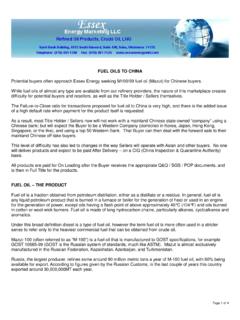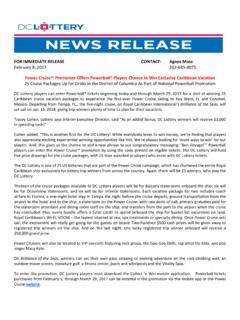Transcription of The pharmaceutical CDMO industry is consolidating - EY
1 The pharmaceutical CDMO industry is consolidatingOpportunities for current players and new entrantsSeptember 20172| Consolidation of the CDMO industry : opportunities for current players and new entrantsWinning strategies in the CDMO industry13 Consolidation of the CDMO industry : opportunities for current players and new entrants |The pharmaceutical contract development and manufacturing organization (CDMO)1 industry is extremely active. In December 2016, Switzerland s CDMO Lonza acquired Capsugel, a development and manufacturing specialist for gelatin capsules, for US$ This was one of the largest deals in the CDMO industry , aimed at building a vertically integrated solutions provider. Only five months later, in May 2017, life science company Thermo Fisher Scientific paid an even higher price to acquire Patheon, one of the leading global CDMOs, for US$ This deal allows Thermo Fisher Scientific to broaden its range of life science services significantly, taking the company closer to its goal of becoming a leading one-stop shop provider to the pharmaceutical industry .
2 These two deals are remarkable in size and represent the largest premiums paid for CDMOs in more than five years: Thermo Fisher Scientific s US$ offer values Patheon at 16x to 17x its expected 2017 EBITDA, in line with Capsugel s 16x multiple. Yet they constitute only the tip of the iceberg of the rising M&A activity in the CDMO industry . In addition to companies solely active in the CDMO industry , pharmaceutical companies have been growing their third-party manufacturing services, , Pfizer s CentreOne and Sanofi s CEPiA. The search for attractive assets is not limited to the CDMO industry : global non- pharmaceutical players are entering the stage to diversify their portfolio, exemplified by the Thermo Fisher Scientific-Patheon deal or the creation of biopharmaceutical CDMO Samsung BioLogics.
3 Given the continual need for outsourced manufacturing and the still fragmented vendor landscape, the CDMO industry is expected to remain a very attractive sector for M&A activity in the The CDMO industry is heating up: consolidation and A highly attractive industry for established players and new entrantsThe CDMO industry started out decades ago as a niche service, offering additional manufacturing capacity or specialty services to pharmaceutical companies. The rise of the CDMOs was fueled by failure stories in the pharmaceutical industry . In the past, pharmaceutical companies often installed dedicated manufacturing capacities for innovative drugs in development, only to see them fail during phase III of clinical research trials.
4 Thus, the additional manufacturing capacity for the specific drugs was no longer needed. To reduce the risk of expensive overcapacities, the demand for outsourced manufacturing has been rising continually. Constituting a US$62b market in 2016, the CDMO industry s annual growth rate of 6% to 7% is slightly outpacing the growth of the pharmaceutical sector as a whole (5% to 6% compound annual growth rate (CAGR)), reflecting the ongoing shift toward increased outsourcing (see references 1 to 3). At a time when pharmaceutical companies face increasing price pressures around the globe from key payers, including public and government insurance systems, reducing operational expenses is a major driver of outsourcing pharmaceutical manufacturing to CDMOs.
5 Also, an increasing number of pharmaceutical companies are refocusing on their core capabilities and strengths, leading to divestments of in-house manufacturing capacities in some areas and to a growing reliance on CDMOs in other , CDMOs play crucial roles in providing additional capacities to mitigate the risk of supply shortages, by offering additional sites for pharmaceutical companies with multisite supply strategies as well as backup capacities. Externalizing manufacturing may also be highly desirable to reduce time to market, in particular if internal expertise or capacities are lot is at stake for pharmaceutical companies when choosing a partner for their manufacturing outsourcing needs. Small biotechnology innovators rely on timely production to enter and proceed swiftly through clinical trials.
6 Also, issues regarding the quality and documentation of the drug manufacturing processes surfacing during regulatory reviews can delay marketing authorization, which poses a significant risk to cash-restrained businesses. Therefore, for small and large pharmaceutical sponsors alike, proven reliability and impeccable quality standards are key to choosing a CDMO. Additionally, it is costly and time-consuming to switch the CDMO once a manufacturing process is established, in particular for biopharmaceuticals. Comprehensive due diligence is crucial in order to prevent potential production delays, revenue losses, damage to a company s or brand s reputation and, in the worst case, health risks for CDMOs are companies engaged in the manufacturing of pharmaceutical drugs on behalf of pharmaceutical companies.
7 4| Consolidation of the CDMO industry : opportunities for current players and new entrantsIndustry segmentation Choosing the right service offering and defining the ideal business model is key for every CDMO aiming for sustainable growth and attractive margins. Indeed, there are significant differences in CDMOs competitive strengths across the segments they are active segmentation of the pharmaceutical CDMO value chain follows three major categories: drug and process development, active pharmaceutical ingredient (API) production and finished dosage form (FDF) (Figure 1). Close to these CDMO core segments are drug discovery and development support, provided by contract research organizations (CROs) as well as contract packaging services, which are provided by CDMOs or specialized contract packaging organizations (CPOs).
8 Tasks outsourced to CDMOs by pharmaceutical companies cover the entire value chain of a drug s life cycle, from drug development and preclinical and clinical trials to commercial production. While traditional CMO services were centered on their core competencies in API bulk manufacturing and formulation, CDMOs have also moved into adjacent segments along the manufacturing value chain. These tasks, which in the past have been covered by pharmaceutical companies themselves or by contract research organizations, include medical chemistry, support for preclinical in vitro and in vivo studies, and formulation and process analytics development. CDMO business modelsAlthough the CDMO industry itself is relatively mature, the advent of new production technologies, new types of pharmaceuticals and priority shifts in the pharmaceutical industry keep the pressure constantly high, causing CDMOs to evolve different business models that enable them to address their clients and stakeholders needs in the best possible way.
9 Today s CDMO business models are a result of historic developments combined with the CDMOs current strategic orientations. Three key business models can be distinguished: 1) the specialty or technology innovator; 2) the capacity consolidator; and 3) the vertical integrator (Figure 2). Specialty CDMOs have an exclusive or very strong focus on one of the segments of the value chain (Figure 1), , finished dose form, and often concentrate on a The rules of the gameDrug discovery Service offering focus Formulation API production CDMO services Target identification Lead discovery Medical chemistry Preclinical studies: in vitro Preclinical studies: in vivo Extraction Synthesis Fermentation: small molecules Fermentation.
10 Large molecules Formulation developmentProcess analyticsdevelopment Te ch transfer Solids Semi-solid Non-sterile liquids Sterile liquids Small-scale production (preclinical phase II) Large-scale production (phase III, commercial) Scale Scale up Other methods Other finished dosage forms (FDF) CRO services Small scale Packaging CPO services Sourcing tnempoleveDDrug developmentCell line developmentPrimary packaging( , blister, strip, bottle, prefilledsyringe)Secondary packaging( , box, carton)Tertiary packaging( , barrel, container)Figure 1: Overview of the CDMO value chain5 Consolidation of the CDMO industry : opportunities for current players and new entrants |certain technology within this segment, such as sterile liquid fill and finish.















